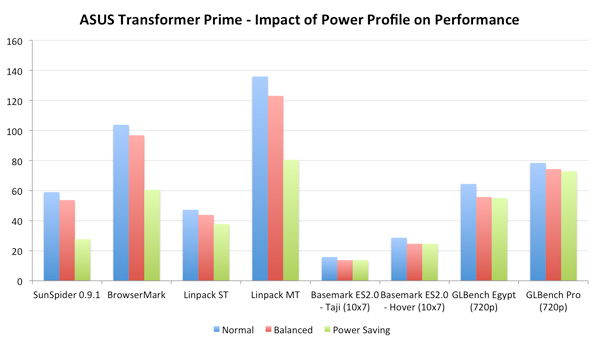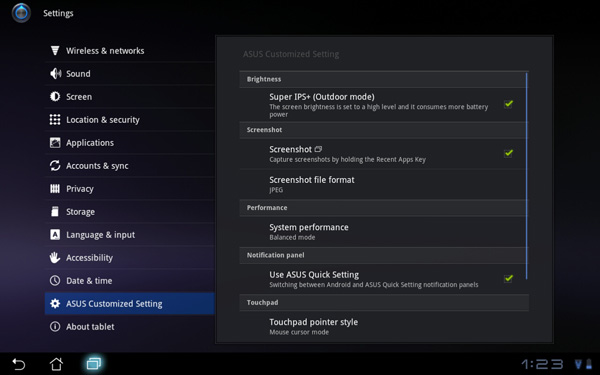ASUS Eee Pad Transformer Prime & NVIDIA Tegra 3 Review
by Anand Lal Shimpi on December 1, 2011 1:00 AM ESTThe Three Power Profiles
There are three power profiles ASUS and NVIDIA have defined on the Prime: Normal, Balanced and Power Saver. Normal allows the CPU to run at up to 1.4GHz with only a single core active, and 1.3GHz otherwise. Balanced is the default setting and it drops maximum CPU clock to 1.2GHz and favors lower clock/voltage targets on the curve compared to Normal mode. Power Saver caps CPU frequency at 1GHz with 1 - 2 cores active, 760MHz with 3 cores active and 620MHz with 4 cores active. It's unclear what the impact is on GPU clocks/performance.
Regardless of power profile, video playback capabilities are untouched - all profiles are able to play 1080p High Profile H.264 content at up to 40Mbps.
The performance impact of these various profiles varies depending on what you're doing. I ran a mixture of CPU and GPU bound tests in all profiles to measure their impact. The results are below:
I reformatted the SunSpider and BrowserMark scores to keep the magnitude of the numbers in line with the rest in the chart, and to make higher numbers = better performance across the board. For the most part you can see that the difference between Normal and Balanced is pretty small. Numerically it works out to be a 5 - 15% gap depending on the benchmark. The latter end of the range is big enough where the performance conscious will want to stay in Normal mode, but it's possible to do without it.
It's interesting to note that the impact on GPU performance isn't that major across the board. It looks like NVIDIA is primarily modulating CPU speed here. The impact on JavaScript rendering performance is huge when you enable the Power Saving mode. In this state the Prime performs like a Tegra 2 based Gingerbread phone.
Power Profiles & Super IPS+ Toggles
Unlike (far too) many of its competitors, ASUS limits its customizations to those that are almost purely functional. ASUS is clearly aware of the fine line between useful improvements and clutter.
The most obvious customization is in the Quick Settings tool:

ASUS' implementation is far busier but it's all extremely useful. You get one tap access to Super IPS+ mode, as well as one tap switching between Power Saving, Balanced and Normal power profiles. I'm pleased to report that toggling any of these modes is pretty much instant, there's hardly any lag between when you tap a button and its impact takes effect. Response time is a particularly important as it directly impacts how frequently the tool is used. In this case I have no issues switching between power profiles because it's pretty much effortless.












204 Comments
View All Comments
joe_dude - Thursday, December 1, 2011 - link
Sorry Anand, but could you clarify what you mean by "getting actual work done"?I don't expect the Transformer Prime to be running Photoshop (although Photoshop Touch is available?) or any intense apps. But is it a "good enough" laptop for a general user?
Anand Lal Shimpi - Thursday, December 1, 2011 - link
Browsing the web is still faster on an MBA/ultrabook, pages load quicker, you can open multiple tabs and load them in the background more effectively - you can switch between tasks quicker (cmd+tab/alt+tab is still infinitely more responsive than what you get with Honeycomb's task switcher). You can get writing done on both, but multitasking and being productive is just easier on a MBA/ultrabook.Now both of those comparisons are ~2x the price of the Prime. Compared to a netbook, I'd definitely get the Prime.
Take care,
Anand
agt499 - Thursday, December 1, 2011 - link
Alt-tab was one of many things that impressed with my OG transformer -you don't use the honeycomb task switcher because you just alt-tab with the keyboard!I have to say asus really get it on that: I don't know for sure if it's asus or google , but the others that warm by keyboard-loving heart are ctrl-t for a new tab in browser and ctrl-w to close a tab.
Also re zooming, I can't speak for the prime, but the original will pinch-zoom with the touchpad.
Thanks for the great review -got to find an excuse to upgrade now!
(you're still right about an ultrabook but it feels like asus are so close...)
twotwotwo - Friday, December 2, 2011 - link
Ahaha -- I managed to use my Transformer all this time lamenting the lack of keyboard-based task switching but without actually trying Alt-Tab, which of course should be the first thing to try. Thank you, agt499.twotwotwo - Thursday, December 1, 2011 - link
I have an original Transformer that I've used as my work machine a few days, and I also used a netbook as my only machine for six months. Transformer's very much a tablet and not a computer, because of Honeycomb. The bad task switching and other annoyances -- different text-editing shortcuts, lack of a full Docs app, lag editing paragraphs in the browser, etc. -- mean it's fine for the reading/consumption that folks do on tablets (and better for e-mail, chat, some writing or notetaking, and SSH if you do that) but, for me, it's worse than even a netbook at other stuff.If you're thinking of it for tablet-y (or mostly tablet-y) uses it's a slam dunk: it's a tablet, great screen, mobile OS, monster battery life even vs. netbooks.
If you want a computer, you want a computer. Besides netbooks and ultrabooks, there's the Core i3 ULV x121e (and others like it soon, I hope) in the middle.
joshv - Thursday, December 1, 2011 - link
Why exactly don't we expect these sorts of machines to be running photoshop? Very complex versions of photoshop ran just fine on single core P6's with a 1024x768 monitor.Now we have four GHz+ cores, CPU speed really can't be much of an issue. Screen realestate might be, but that's manageable with alternate layouts.
metafor - Thursday, December 1, 2011 - link
I think the biggest limitation with programs like Photoshop on small form-factor devices -- including ultrabooks -- is the display resolution. Now granted, for a lot of simple photo editing, that won't matter -- and in fact, that's what Photoshop Touch is for -- but for more professional level content, the displays may just be too small and low-resolution to get the job done.But you're right, the processing power is there nowadays.
anactoraaron - Thursday, December 1, 2011 - link
I always assumed it was an x86 issue. Since there's no x86 support in these devices Adobe will not re-write/compile the software - kinda like how it took years to have a native x64 flash player (and not a x86 kinda running in an x64 browser).I would think it's simply a matter of laziness/unwillingness (profit margin?) on Adobe's part.
metafor - Thursday, December 1, 2011 - link
Photoshop Touch and a suite of other tools is coming to Android within a month or so. Adobe wants to grasp opportunities; but just porting a mouse-and-keyboard application to Android isn't the way to go about it.ctrlbrk - Thursday, December 1, 2011 - link
Anand, thank you. I have been eyeing this tablet for a long time now.I want to know your impressions of how it feels in your hands, weight wise? For bedroom surfing, email, youtube, etc -- but not movie watching -- is the 10.1 too big and too heavy? Is it better to get something like the Galaxy Tab 8.9?